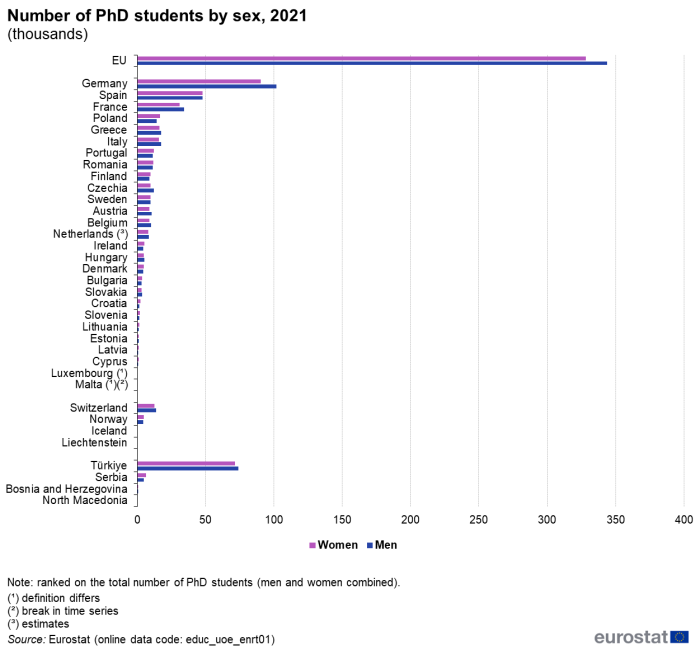R&D personnel
Data extracted in November 2023
Planned article update: July 2024
Highlights
More than half (56.6 %) of full-time equivalent researchers in the EU worked in business enterprises, 32.0 % in higher education and 10.1 % in the government sector in 2022.
This article analyses preliminary data for 2022 on research and development (R&D) personnel, researchers, human resources in science and technology (HRST) and doctorate/PhD students in the European Union (EU). Statistics on science and technology personnel are key indicators for measuring the knowledge-based economy and its developments, for example, providing information on the supply of and demand for, highly qualified science and technology specialists.
Full article
Researchers
The number of researchers in the EU has increased in recent years: there were 2.08 million researchers (in full-time equivalents (FTE)) employed in the EU in 2022 (see Figure 1), which marked an increase of 648 000 when compared with 2012. The number of researchers (FTE) more than doubled in Poland, Sweden and Greece between 2012 and 2022, totaling 141 200, 103 800 and 50 100 respectively last year. Relatively high growth rates were also recorded in Hungary (92 %), Cyprus (82 %) and Belgium (77 %). At the opposite end of the range, with small growth rates were Latvia (7 %) and Romania (6 %).
Among the non-EU member countries shown in Figure 1, the number of researchers in China (excluding Hong Kong) reached 2.28 million in 2022. During the period 2012-2022, the number of researchers in Türkiye more than doubled. South Korea also recorded a rapid increase in the number of researchers (up overall by 42.0 %). The rapid growth was also noted in China, up overall by almost two-thirds (62.5 %). In the United States the growth rate was 26.6 % (2019 data). The number of researchers rose by 7.2 % in Japan between 2012 and 2022.

Source: Eurostat (rd_p_persocc) and OECD database
An analysis of R&D personnel by sector in 2022 (see Figure 2) shows that in the EU there was a high concentration of researchers in the business enterprise sector (56.6 %) and the higher education sector (32.0 %), while 10.1 % of the total number of researchers were working in the government sector. The relative importance of the different sectors varied considerably across the EU Member States, with business sector accounting for three-fifths or more of all researchers in Sweden, the Netherlands, Austria, Belgium, France, Germany, Finland and Hungary. By contrast, the countries with the highest share of researchers working in the government sector were Romania (34.6 %), Bulgaria (27.6 %) and Luxembourg (22.6 %). A majority of researchers working in Latvia (56.7 %), Lithuania (53.4 %), Ireland (52.6 %), Slovakia (51.6 %) and Portugal (50.4 %) were employed within the higher education sector. This sector also accounted for a high share (although less than 50 %) of all researchers in Greece, Cyprus, Malta, Croatia and Spain. In terms of its number of researchers, the private non-profit sector was the smallest in all EU Member States, its highest share (10.6 % of all researchers) was recorded in Cyprus, while the next highest shares were in Italy (3.0 %) and Germany (2.4 %). In the remaining 18 countries for which the data for this sector are available, it ranged between 0.0 % and 1.8 %.
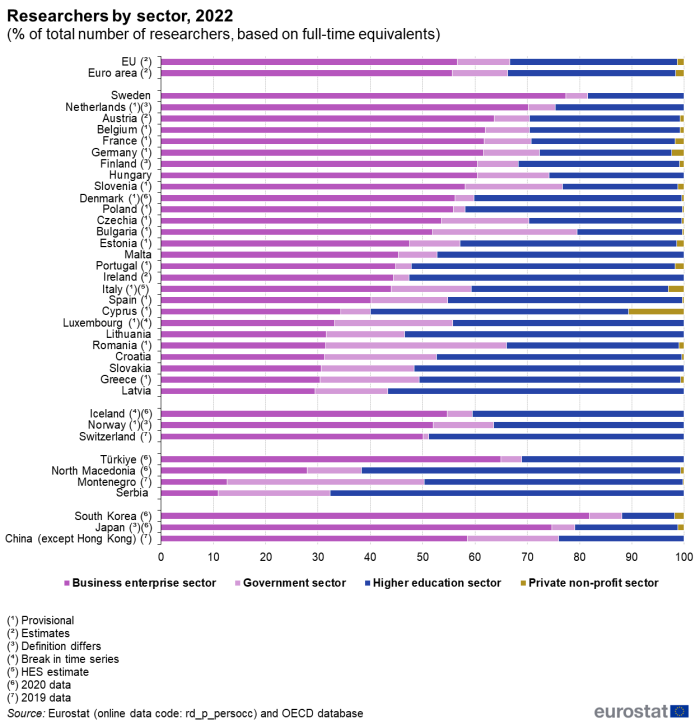
Source: Eurostat (rd_p_persocc) and OECD database
An analysis by sex shows that men accounted for approximately two-thirds (66.3 %) of the EU's workforce of researchers in 2021 (expressed in head count). The share of women in the total number of researchers was close to parity in Latvia, Croatia, Lithuania, Bulgaria and Romania, all above 45 % (see Figure 3). The gender gap was largest in France, Luxembourg, Germany, Hungary and Czechia where women made up less than 30 % of all researchers.
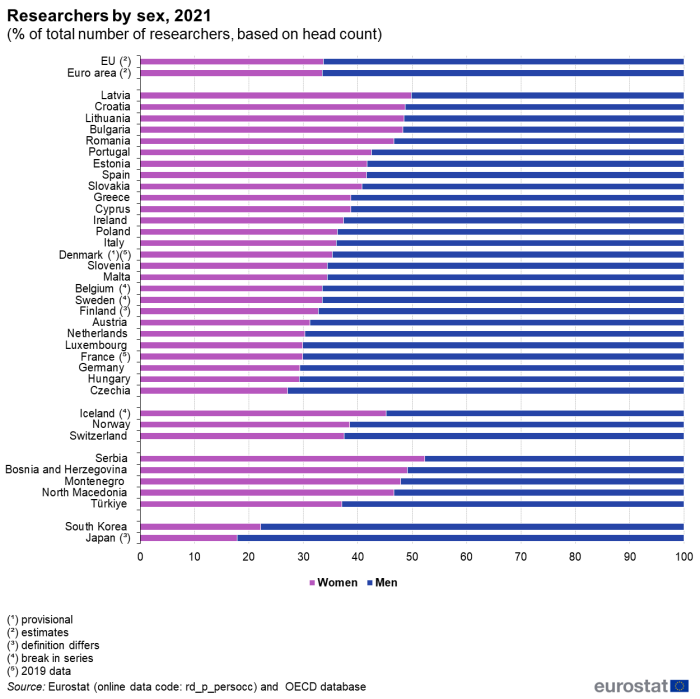
Source: Eurostat (rd_p_persocc) and OECD database
R&D personnel
R&D personnel in all sectors together accounted for more than 2.0 % of the total employment in Sweden, Belgium, Austria, the Netherlands, Finland and Denmark (2021 data), compared with an EU average of 1.6 % (Note: these figures are based on information in full-time equivalents). Aside from the above countries mentioned, the share of R&D personnel in the total employment ranged from 0.5 % in Romania and Cyprus to 1.9 % in Germany (see Figure 4).

Source: Eurostat (rd_p_perslf)
Human resources in science and technology
Human resources in science and technology (HRST) provide information concerning the demand for and the supply of people with high qualifications in science and technology. Around 75.9 million people in the EU were employed in science and technology (S&T) occupations in 2022, this made up one-third (35.2 %) of the total labour force aged 15-74 years (see Figure 5). Persons in S&T occupations accounted for over half (56.9 %) of the total labour force in Luxembourg in 2022 and for around two-fifths in Sweden (46.9 %), the Netherlands (46.7 %), Denmark (44.1 %), Finland (42.4 %), Slovenia (40.8 %), Germany (40.7 %) and Belgium (39.1 %). By contrast, the lowest shares of people working in science and technology occupations were recorded in Romania (23.8 %), Greece (25.4 %), Bulgaria (26.1 %) and Spain (27.3 %).
Although the letters S&T in the official definition of HRST in the Canberra manual refer to science and technology, the definition is not limited to science and technology in the strict sense. HRST by education covers all fields of study, in other words anybody who successfully completed a tertiary level education. The HRST 'core' (HRSTC) — which is made up of people who possess a tertiary level education and who are employed in science and technology occupations — amounted to 51.4 million persons in 2022 across the whole EU and accounted for one-fifth (23.9 %) of the total labour force. Concerning the HRST 'core', Italy (16.4 %), Romania (16.8 %) and Slovakia (19.3 %) were the EU Member States reporting the lowest figures of their labour force in that category in 2022. At the other end of the scale, HRSTC accounted for more than one-quarter of the labour force in Luxembourg (44.3 %), Sweden (33.5 %), Belgium (32.1 %), Finland (30.6 %), the Netherlands (30.5 %), Slovenia (30.4 %), Ireland (30.0 %), Denmark (29.9 %), Lithuania (29.5 %), France (28.2 %), Cyprus (28.0 %) and Estonia (26.0 %). (see Figure 5).
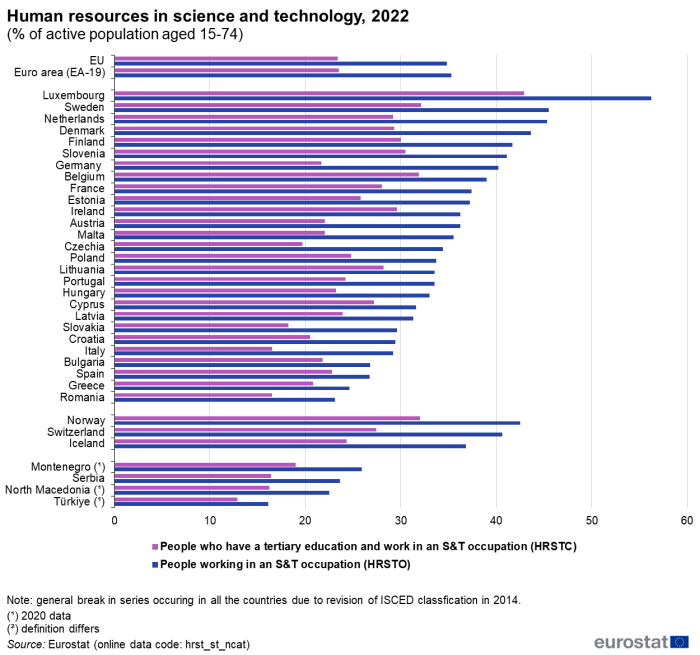
Source: Eurostat (hrst_st_ncat)
Between 2012 and 2022 there was a considerable increase in the relative importance of people classified as HRST ‘core’ within the EU's labour force, as their share rose by 5.7 percentage points (pp) (see Figure 6) from 18.2 % to 23.9 % in 2022. In fact, this share increased in all EU Member States. The largest increases in the relative importance of the HRST core workforce were recorded in Slovenia (11.4 pp), Portugal (10.9 pp), Austria (9.5 pp), Sweden (9.3 pp), the Netherlands (8.5 pp), Luxembourg (8.4 pp) and France (7.2 pp).

Source: Eurostat (hrst_st_ncat)
Science and technology graduates
Moving away from the broad definitions of HRST, Figures 7 and 8 look at the international standard classification of education (ISCED) levels 5-8 (tertiary education) in the field of science and technology covering natural sciences, mathematics and statistics; information and communication technologies; engineering, manufacturing and construction. Within the EU (2021 data), there were 21.9 graduates of science and technology fields of education per 1 000 persons aged 20 to 29 years. Among the EU Member States (2020 data), relatively high ratios — above 20.0 graduates per 1 000 persons aged 20 to 29 years — were recorded in Ireland, France, Denmark, Finland, Austria, Germany, Spain, Portugal, Croatia, Slovenia and Greece. In Ireland this ratio peaked at 40.4 graduates per 1 000 persons aged 20 to 29 years. This ratio should be interpreted with care as some graduates reported by a country may be foreigners who return home following their studies and so push up the ratio in the country where they studied and pull down the ratio for their country of origin. This may explain to a large extent the very low ratio recorded in one of the smallest EU Member States, namely Luxembourg (4.9 graduates from science and technology fields of education per 1 000 persons aged 20 to 29) and also the relatively low ratio recorded for Malta (10.1) and Cyprus (10.5).
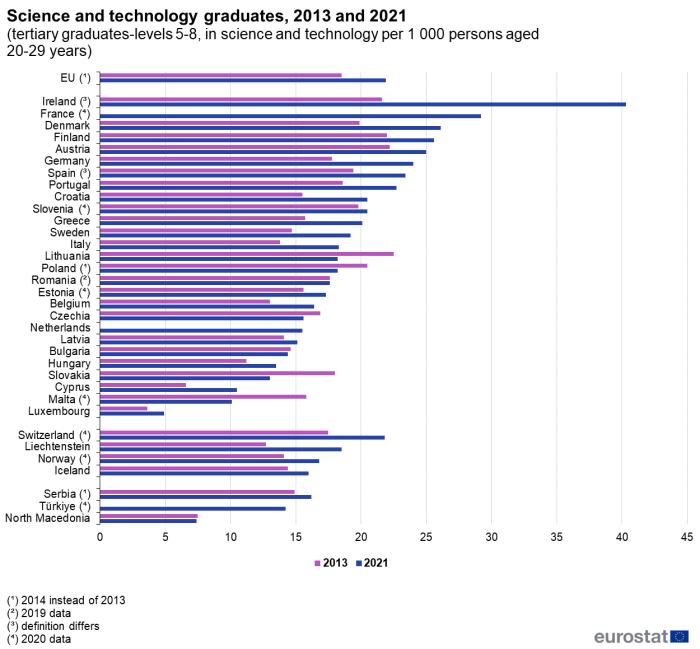
Source: Eurostat (educ_uoe_grad04)
An analysis of science and technology graduates by sex shows that men (aged 20-29 years) are more likely to graduate in these fields than women. In 2021, the EU registered 28.7 male tertiary graduates in science and technology per 1 000 men aged 20-29 years and 14.8 female tertiary graduates per 1 000 women of the same age, a difference of 13.9 per 1 000. A gender gap was observed in all EU Member States in 2021, ranging from 3.4 per 1 000 in Luxembourg and 3.8 per 1 000 in Romania to 25.6 per 1 000 in Ireland.
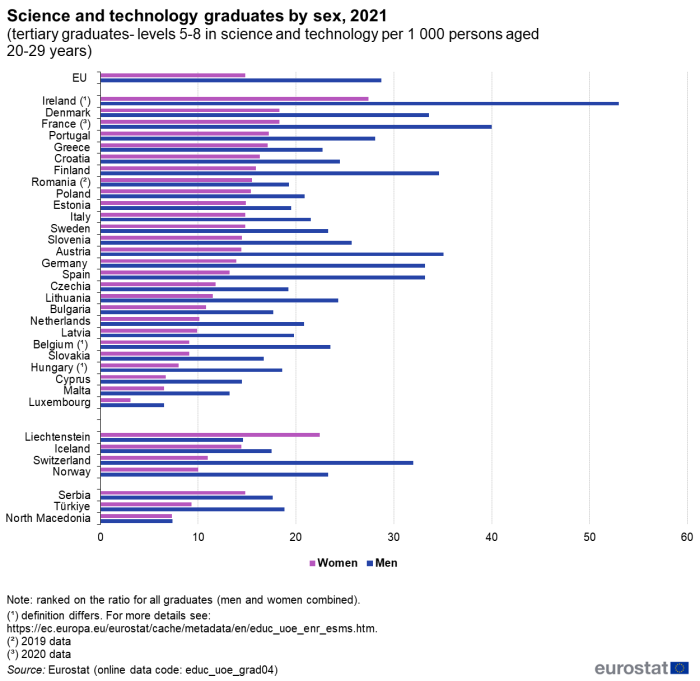
Source: Eurostat (educ_uoe_grad04)
Doctoral students
A similar but more specific measure of a country's potential research capability is provided by the number of doctoral (PhD) students (see Figure 9). In 2021, there were an estimated 672 000 doctoral students in the EU. Women accounted for slightly less than half (an estimated 48.8 %) of doctoral students in the EU in 2021.
The gender split of doctoral students across the EU Member States was typically quite balanced: women accounted for more than half of all the doctoral students in 15 out of the 27 EU Member States in 2021, their share peaking at 58.9 % in Cyprus, 56.7 % in Lithuania and at 55.9 % in Croatia. Among the 11 EU Member States where a higher number of male than female PhD students was observed, the share of men peaked at 56.8 % in Luxembourg and at 55.9 % in Czechia and 54.2 % in Austria. In one EU Member State (Sweden), the share of women and men was equal.
In relative terms, the broad group covering science and technology accounted for 39.8 % of the doctoral students in the EU in 2021.
Among the EU Member States, science and technology fields of education accounted for more than half of all doctoral students only in Luxembourg (63.2 %) and Italy (52.7 %). These fields were also very popular among students in France, Czechia, Estonia, Lithuania, Ireland, Sweden, Belgium, Croatia and Germany where the shares ranged between 40.2 % and 48.7 %.The lowest proportion of PhD students in S&T fields of education was recorded in Malta (12.2 %), Bulgaria (26.5 %) and the Netherlands (31.0 %). The other fields of education for doctoral studies in the EU ranked in terms of popularity were health, welfare and services (20.0 %), social science, business and law (19.1 %) education, arts and humanities (17.0 %), and agriculture and veterinary (2.6 %).

Source: Eurostat (educ_uoe_enrt03)
Source data for tables and graphs
Data sources
R&D personnel
Statistics on R&D personnel are compiled using guidelines laid out in the 7th edition of the Frascati manual, published in 2015 by the OECD; the manual was updated with improved guidelines reflecting changes in the way that R & D is funded and carried out — see the Frascati manual 2015.
R&D personnel include all persons employed directly within R&D, as well as persons supplying direct services (such as managers, administrative staff and clerical staff). For statistical purposes, indicators on R&D personnel are compiled as both head counts (HC) and as full-time equivalents (FTEs).
Researchers are a subcategory of R&D personnel and are professionals engaged in the conception or creation of new knowledge, products, processes, methods and systems, and in the management of the projects concerned.
Human resources in science and technology (HRST)
Statistics on human resources in science and technology (HRST) are compiled using guidelines laid out in the Canberra manual, prepared in cooperation between the OECD, European Commission, UNESCO and the International Labour Organisation (ILO) and published in 1995. HRST data can be analysed by sex, age, region, sector of activity, occupation, educational attainment and fields of education (although not all combinations are possible). Data relating to stocks of HRST provide information on the number of HRST at a particular point in time, these stock data relate to the employment status as well as the occupational and educational profiles of individuals.
HRST based on education (HRSTE) are persons having successfully completed tertiary education, defined as levels 5, 6, 7 or 8 of the 2011 version of the international standard classification of education (ISCED). Previously it was defined as levels 5 (a or b) or 6 of the 1997 version of ISCED.
HRST based on occupation (HRSTO) are persons who are employed in science and technology occupations as 'professionals' or 'technicians and associate professionals' within the international standard classification of occupations (ISCO-08).
Persons who fulfil both the education and the occupation criteria are classified as the HRST 'core' (HRSTC).
Information on HRST flows from education are obtained from a UNESCO/OECD/Eurostat questionnaire on education and can be used to provide a measure of the current and future supply of HRST from the education system, in terms of actual inflows (graduates from the reference period) and potential inflows (students participating in higher education during the reference period).
Science, technology and innovation
Statistics on science, technology and innovation were collected based on Commission Implementing Regulation (EU) No 995/2012 concerning the production and development of Community statistics on science and technology until the end of 2020. Since the beginning of 2021, the collection of R&D statistics is based on Commission Implementing Regulation (EU) No 1197/2020 of 30 July 2020.
Science and technology graduates are defined as the number of new graduates from all public and private institutions completing science and technology related graduate and postgraduate studies in the reference year. To facilitate comparisons, the number of graduates may be expressed relative to the total number of persons aged 20-29 years and 25-29 years.
Doctoral students
Indicators based on the number of doctoral (PhD) students give an idea of the extent to which countries will have researchers at the highest level of education in the future. The data relate to the number of students in the reference year, they do not refer to the number of new graduates or to the total number (stock) of graduates in the labour market that year. The number of doctoral students is measured as students enrolled in ISCED 2011 level 8: this level concerns tertiary programmes which lead to the award of an advanced research qualification. Programmes at this ISCED level are devoted to advanced study and original research and are typically offered only by research-oriented tertiary educational institutions such as universities. Doctoral programmes exist in both academic and professional fields.
Context
The European Research Area (ERA) is composed of all research and development activities, programmes and policies in Europe which involve a transnational perspective. In May 2008, the European Commission adopted a Communication to launch an initiative titled, Better careers and more mobility: a European partnership for researchers (COM(2008) 317 final). The goal of this initiative is to improve the mobility of researchers and to enhance the diffusion of knowledge throughout Europe, by: balancing demand and supply for researchers at a European level, helping create centres of excellence and improving the skills of researchers in Europe.
With this in mind, the EU and its Member States set-up a pan-European initiative — EURAXESS: researchers in motion — which is designed to deliver information and support researcher mobility and career development, while enhancing scientific collaboration between Europe and the world. The same gateway is also used to promote the European Commission's initiative titled Science4Refugees, which is designed to help refugee researchers find jobs and to support refugee scientists in finding European researchers with whom they may discuss problems, find solutions and study together.
In December 2008, the Competitiveness Council adopted a definition for a 2020 vision for the ERA. According to the opening statement of this vision, all players should benefit from: the 'fifth freedom', introducing the free circulation of researchers, knowledge and technology across the ERA; attractive conditions for carrying out research and investing in R & D intensive sectors; Europe-wide scientific competition, together with the appropriate level of cooperation and coordination. This vision is part of the wider goals contained within the Europe 2020 strategy for smart, sustainable and inclusive growth.
In November 2011, the European Commission presented a successor for the 7th framework programme for research and technological development by announcing Horizon 2020, a programme for investing nearly EUR 80 billion in research and innovation, implementing the innovation union. The Marie Sklodowska-Curie actions, under the 'excellent science' pillar of Horizon 2020, aim to support the career development and training of researchers — with a focus on innovation skills — in all scientific disciplines through worldwide and cross-sector mobility.
Direct access to
- Science, technology and innovation in Europe (Pocketbook — 2013 edition)
- Science, technology and innovation in Europe (Pocketbook — 2012 edition)
- Science, technology and innovation in Europe (Pocketbook — 2011 edition)
- Science, technology and innovation in Europe (Pocketbook — 2010 edition)
- Science, technology and innovation in Europe (Statistical book — 2010 edition)
- (t_scitech), see:
- Research and development (t_research)
- Statistics on research and development (t_rd)
- Total researchers by sectors of performance - head count (tsc00003)
- Total researchers by sectors of performance - full time equivalent (tsc00004)
- Research and development personnel, by sectors of performance (tsc00002)
- Share of women researchers, all sectors (tsc00006)
- Share of women researchers, by sectors of performance (tsc00005)
- Statistics on research and development (t_rd)
- Human resources in Science & Technology (t_hrst)
- Human resources in science and technology (HRST) (tsc00025)
- Doctorate students in science and technology fields (tsc00028)
- Education and training outcomes (t_educ_outc)
- Science and technology graduates by sex (tps00188)
- Research and development (research)
- Statistics on research and development (rd)
- R & D personnel at national and regional level (rd_p)
- Statistics on research and development (rd)
- Human Resources in Science & Technology (hrst)
- Stocks of HRST at national and regional levels (hrst_st)
- Flows of HRST at national level (hrst_fl)
- Research and development (research)
- Participation in education and training (educ_part)
- Pupils and students - enrolments (educ_uoe_enr)
- Tertiary education (educ_uoe_enrt)
- Pupils and students - enrolments (educ_uoe_enr)
- Education and training outcomes (educ_outc)
- Graduates (educ_uoe_grad)
- Statistics on research and development (rd) (ESMS metadata file — rd_esms)
- Human resources in science & technology (hrst) (ESMS metadata file — hrst_esms)
- Education administrative data from 2013 onwards (ISCED 2011) (ESMS metadata file — educ_uoe_enr_esms)
- Decision No 1608/2003/EC of 22 July 2003 concerning the production and development of Community statistics on science and technology
- Summaries of EU legislation: Science and technology statistics
- Regulation (EC) No 753/2004 of 22 April 2004 implementing Decision 1608/2003/EC
- Regulation (EU) No 995/2012 of 26 October 2012 implementing Decision 1608/2003/EC
- European Commission — Directorate-General for Internal Market, Industry, Entrepreneurship and SMEs European innovation scoreboards
- European Commission — Directorate-General for Research and Innovation — Science with and for society
- European Commission — EURAXESS — Researchers in motion
- European Commission — Horizon 2020
- European Commission — Joint Research Centre (JRC) — The EU Industrial R & D Investment Scoreboard
- World Intellectual Property Organization (Eurostat R&D data is being used by the World Intellectual Property Organization notably to calculate the Global Innovation Index)
